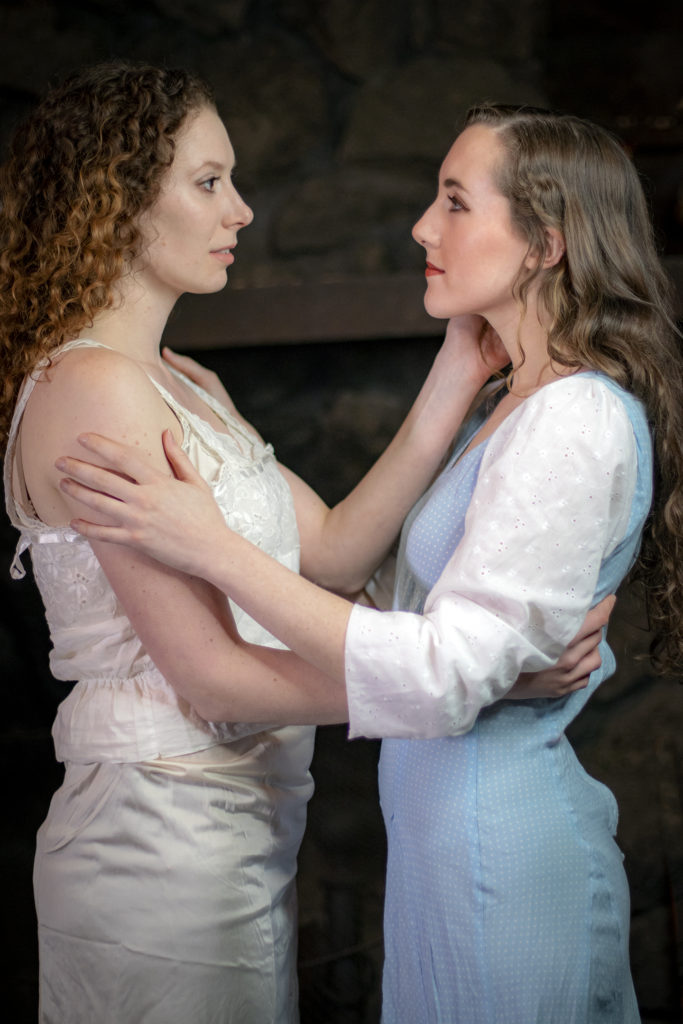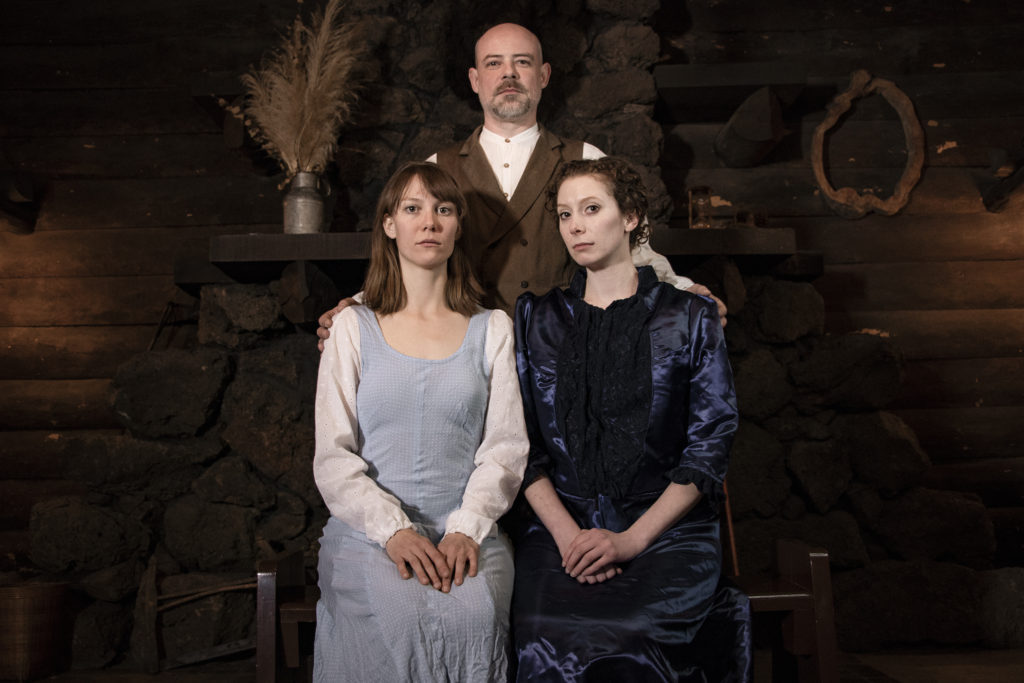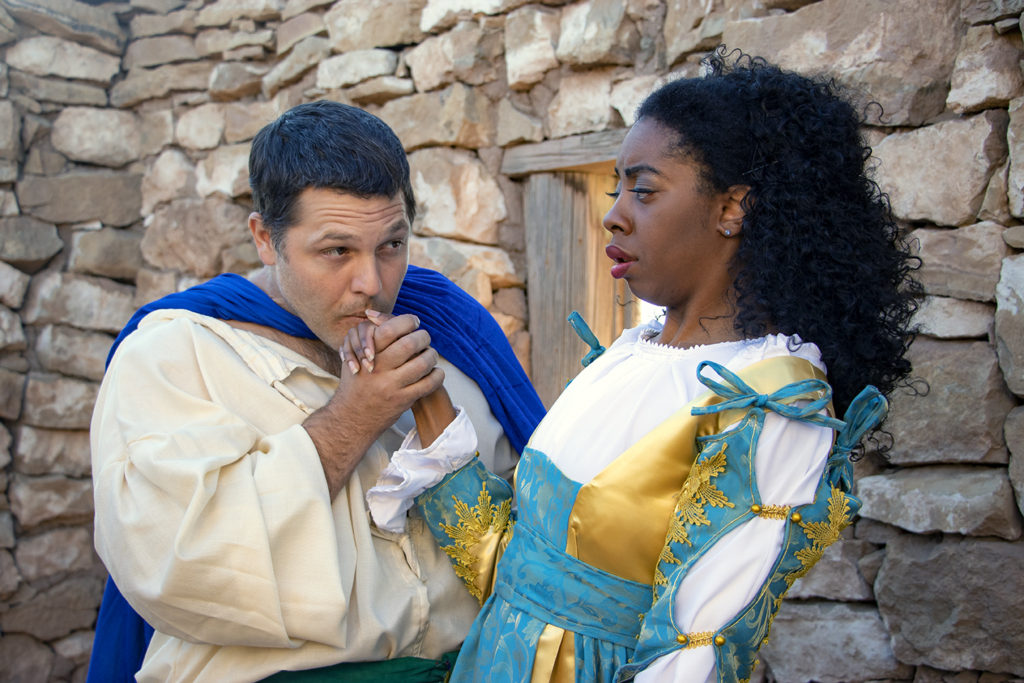by Mac MacDaniel
One of the most rewarding things about being a fan of any artist, especially one with a long career, is watching their style evolve. Some of my favorite musicians — Metallica, Tom Waits, Tupac — have distinct artistic periods that are often in conversation with each other. Listening to Tom Waits’s early piano-heavy crooner records, you might not even realize that this is the same artist of albums like Bone Machine that feature morbid criminal ballads over instrumentation that sounds like — and sometimes is — just Tom banging on random objects. Tupac’s revolutionary social commentary on his early records evolves into the violent, confrontational rhymes on his later work. Fans felt betrayed when Metallica wrote their first radio-friendly record, cutting both their hair and their guitar solos, but that particular album has aged much better than its detractors.
And it’s obviously not just music. Lovers of Monet, Rodin, or the Coen Brothers will happily talk your ear off about the relative merits of those artists’ early or later work. Even if you don’t love your favorite artist’s entire oeuvre, you can see how their work evolves, how they revisit themes and ideas and imagery again and again, how they approach concepts as they become more deft and experienced in their craft.
As a great lover of Shakespeare, one of my biggest joys is in juxtaposing his early, middle, and late plays. You can see a twinkling of Romeo and Juliet in the eye of the playwright who starts out writing Two Gentlemen of Verona. A nihilistic middle play like King Lear might heighten your appreciation of the redemptive elements of a later play like The Tempest.
When I am trying to expose a friend to an artist whose work has meant a lot to me, I try to give them a sampling of that artist’s work from each period, like a flight of drinks. To give a taste for Tom Waits’s material, I might suggest that a friend try out three “B” records, because there’s a good album starting with a “B” in each period of his career. An early album like Blue Valentines, 1978, contrasts nicely with a middle album like Bone Machine, 1992, and then you can round off the flight with Bawlers, Brawlers & Bastards, from 2006.
Similarly, if you want to develop your palate for Shakespeare, I can’t think of a better experience than seeing the three plays that FlagShakes has selected for their 2022 season. One comedy from Shakespeare’s early career, one tragedy from his middle period, and one late play that defies genre conventions, sometimes grouped in with the late romances.
The Comedy of Errors, on this fall, is a light, silly, short play full of slapstick humor and mistaken identity. It’s representative of Shakespeare’s early work: over the top, full of rhyme, and with characters who are more caricatured and less developed than in his later works. Shakespeare’s early work, both comedy and tragedy, is so extra. Like Metallica said of their early shows, in order to get folks to pay attention to them, they had to play faster and louder than anyone else. The early Shakespeare seemed to think that the key to humor was just adding more. If one set of identical twins is funny, then it follows that two sets is even funnier, at least that appears to be his logic behind The Comedy of Errors, and because he’s Shakespeare, he succeeds where another writer might have failed. To see the same principle on the flip side of the coin, look at an early tragedy like Titus Andronicus, where the young Shakespeare seemed to think that by the same token, adding more dead bodies would make a play even more tragic. The jury’s still out on whether the principle holds up in tragedy as well as it does in comedy.
Othello, FlagShakes’s summer Shakespeare show, couldn’t be more different than The Comedy of Errors, both in terms of genre and writing style. If Comedy of Errors is about as light as Shakespeare plays get, Othello is perhaps as heavy as they get. Othello is more poetic, less rhyming, with characters who are much more three dimensional. Unlike the world of Comedy of Errors — where violence and injustice do occur, but are mostly perpetrated by well-meaning people who deserve forgiveness — the world of Othello is dominated by a scheming psychopath who refuses not only to repent, but to even explain his motivations. The tragedy of Othello is not only in the harm that occurs, but in the fact that it feels meaningless and random. The language of Othello is more muscular, more efficient, more noisy, not unlike Metallica’s middle period.
The final Shakespeare production of FlagShakes’s season, The Two Noble Kinsmen, is a strange play indeed, and for a few different reasons. It defies traditional genre conventions, sometimes called a “tragicomedy” — which means exactly what it sounds like — and sometimes lumped in with the other late plays that we call “romances.” It is also probably a collaboration between Shakespeare and a younger playwright, John Fletcher. Shakespeare’s later work is fascinating because at the end of his career, Shakespeare seemed more open to writing the nuance of real life, playing with the blurry line between happy and sad endings, between a just and an unjust universe, and between wrongs that can be righted and wrongs which cannot. The Two Noble Kinsmen is a wonderful adventure story that is — in my humble opinion — underrated. It deals with rich themes and ideas: the fact that sometimes we have to do the right thing for the wrong reason, sometimes getting exactly what we wish for isn’t a blessing, and sometimes a pleasant lie is better than the painful truth.
Shakespeare’s final plays remind me of the final record that Tupac worked on before his death. Like Shakespeare, Tupac continued publishing material after he died. The 7 Day Theory feels like a blending of the two extremes of Tupac’s career, from the more thoughtful political work of his early records to the more combative, beef-oriented work of his career on Death Row Records. In much the same way, Shakespeare blends comedy and tragedy at the end of his career. The maturity and power of both artists at the end of their careers makes me wish that they had been able to continue working for longer.
If you’ve ever had a drink flight — most commonly seen with beers, but for those of us who don’t drink alcohol, some coffee shops do flights of different coffees — you’ve probably noticed that it’s much easier to discern differences between similar drinks when you taste them in succession. I’ve always been a big coffee drinker, but up until I started going to coffee “cuppings,” I mostly thought that coffee was coffee. The first time I tasted a washed Colombian coffee right after a natural Ethiopian coffee, I realized just how much flavor variation there truly is. That made me appreciate all coffees that much more. I’m sure the experience is similar for folks developing their palates for different beers and liquors.
So, in 2022 I would encourage you to come out and see FlagShakes’s “Shakespeare Flight,” sample plays from different periods in Shakespeare’s career as a playwright, see his takes on different genres and themes, and pay attention to how his poetry deepened, from the rhyming witticisms of his early plays into the Baroque despair of his middle period, to the musical, magical transcendent verse of his late plays.
Mac MacDaniel is the artistic director of Elsewhere Shakespeare and the author of The Play’s the Thing: A Beginner’s Guide to Seeing and Enjoying Shakespeare.
*The above mentioned 2022 production of The Two Noble Kinsmen has been postponed until 2023. Want to see all of our shows in the 2022 season? Purchase season tickets today!
What would you say if everyone you loved came back for just one day? Where would you go? What would you do?
Winter’s Tale is a tale of loss and redemption. Historically a winter’s tale was something told by the fireside to entertain and keep the dark shadows at bay. Shakespeare titled his play “THE Winter’s Tale,” presumably, to make known this was the last winter’s tale anyone would ever need. His play has everything one wants in a story and would become the only tale needed for a dark and stormy night. He was right.
Among many things, this play shows the duality of humanity set amid the two extremes of our seasons: winter and summer. Shakespeare starts us in Sicilia in winter, juxtaposing the harsh elements with the joy of the court. We end up in summertime Bohemia, a time of joy and rebirth. A pastoral place filled with whimsy and laughter where anything can happen. I wanted to portray this duality in our casting by doubling our characters. Our company gets the opportunity to delve into all aspects of human nature as they take on two or more contrasting roles.
The Winter’s Tale comes at the end of Shakespeare’s career. He will pen one more masterpiece, The Tempest, before retiring to Stratford-Upon-Avon. We can see the brilliance and complex nature of his poetry in these final plays. He has learned much during his life as an artist. And, as we sit in this theater in 2019, there is still so much we can learn from his poetry. How to forgive, how to live life to the fullest, how to love completely, and how to keep faith no matter “destiny say no.” As an audience, we can find a piece of ourselves in every character on this stage. I invite you to lean into this story. Listen to these words and the emotional storytelling behind them. Come with us, and experience a world where actions may have consequences, but ultimately dreams do come true.
Thank you for supporting live theater and for keeping the arts alive. Enjoy!
Amie Bjorklund
Director, Winter’s Tale
Last year when Titus Andronicus closed, I knew I wanted to direct
another revenge tragedy. Duchess of Malfi was a famous play in its time and is titled a “revenge tragedy,” and I remembered Ferdinand’s powerful “Upon a time” speech from grad school, so I thought of it immediately. We strive to produce plays audiences will be experiencing for the first time alongside Shakespeare’s beloved classics, so it seemed like a great choice.
In re-reading, however, I found it was not a revenge tragedy at all,
but rather a beautiful romance, a heroic tragedy. Compared to
Titus, in which the first death takes place in the first four lines, no
one in Duchess dies until after intermission. And when they do, the
first five deaths are bloodless. (OK, a lot of people die, true, but no
more than in Hamlet or Romeo and Juliet) Duchess is not a story
of revenge, but a story of redemption. It’s not a blood bath, but
a parable about the danger of choosing money above love and
power above empathy.
Perhaps most fascinatingly, it’s a play about a real woman. Duchess Giovanna d’Aragona came into more power, through accident and not desire, then her brothers could climb to with all their conniving and violence. She maintained peace for her people in a time of war, and she loved a man for his character in a culture where titles meant more than virtues. Then, she and her love and their children were all brutally murdered; not for “revenge,” but out of greed and false pride.
In Webster’s version, there is a character who is no more than a
footnote in history: Bosola. But in Webster’s Bosola, we are invited
to understand the pressures of poverty on a man’s moral fortitude and to allow for the possibility of redemption even after the darkest of deeds.
Welcome to Malfi. I hope you enjoy its romance, intrigue… and
touch of madness.
Dawn Tucker
Director, Duchess of Malfi
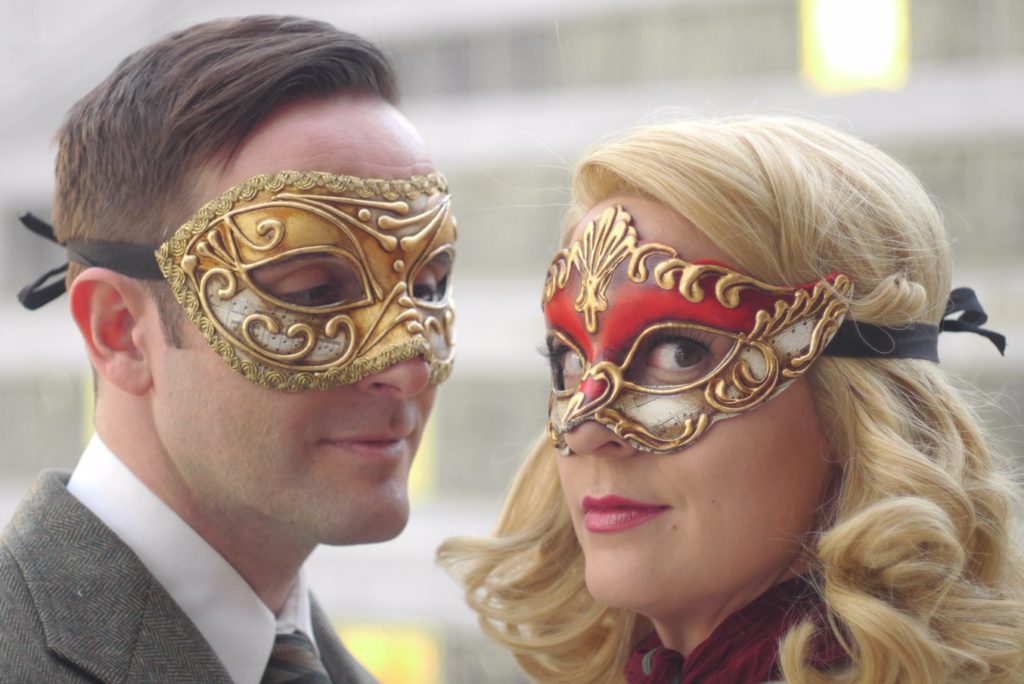
Right in the middle of William Shakespeare’s career—after he’d toiled for years on wonderful but methodical comedies such as The Comedy of Errors and The Taming of the Shrew (written in verse, grounded in rigid Italian structure and almost devoid of song) and just before his later period of lyrical, poetic work (filled with music and pulsing with the wit of fools) such as As You Like It and Twelfth Night—he performed a strange experiment. He gave the world a cracking comedy that broke all the rules, was written almost entirely in prose, and was populated by decidedly older characters. The language in this play sounds shockingly contemporary, and the characters that speak it seem to come from our own neighborhoods. Much Ado About Nothing stands by itself as a unique work, not only for having one foot in each of these distinct periods of Shakespeare’s writing, but for being the most accessible, warmest, and funniest comedy he ever penned.
Much Ado About Nothing concerns a community of people starting their lives again after being torn apart by a foreign war. The war that
takes place prior to curtain is presented as necessary and righteous, and I chose for our setting, New Orleans in the summer of 1945, immediately following World War II. While tragic and horrific, the war lives in our national memory as a moral and justified conflict. New Orleans
had an outsized role in that war. It was an embarkation point, with a
massive naval base. The sailors and fishermen of southern Louisiana
were under constant attack by German submarines in the Gulf of
Mexico during the war: hundreds of vessels were attacked and sunk
and thousands of people were pulled from the waters by both military
craft and civilian patrol boats. The people of the city dove headlong into the industrial war effort. Mardi Gras was put on hold for the duration, as the amphibious landing vehicles that were used to turn the tide of war were being designed and built by New Orleanians. The city was chosen as the site for the National World War II Museum for these reasons, and it remains a city challenged by history and geography. Above all, it is a city of beauty, magic, music, and celebration: a lovely parallel to the Messina of Much Ado About Nothing.
Jesse James Kamps
Director, Much Ado About Nothing
Every day, on my way to rehearsal, I drive past the location of Chabad’s future
Molly Blank Jewish Community Center and see hundreds of tinfoil hearts glittering as I go by. I am reminded of the ability of a community to come together in support and love despite the hate and ignorance that somehow still exist
today. Our plan and process for Indecent began long before the disgusting
(inhumane, sad, unconscionable) vandalism at Chabad of Flagstaff, but only after that did I truly understand the urgency of telling this story.
In a community like Flagstaff, it can be easy to mistakenly believe that we are far removed from anti-Semitism and hate crimes. The Flagstaff community needs and deserves theater that inspires empathy and connects us to the human experiences that bring us all together. It is inspiring to see so many
people come together in a moment of need to support the local Jewish community, and I hope we will be embracing, and celebrating, diversity all the time. Our goal when undertaking this journey was to elevate empathy. Through truthful playwriting and the dedicated craft of our skilled actors, I hope you laugh, I hope you cry, and more than anything, I hope you enjoy the show.
Cameron Scully
Director, Indecent
I’ve always found the arts to be an incredible source of healing, learn-
ing, and connection with others. The start of a new project is an ex-
citing and daunting time when you don’t know how things will turn out, if you’ll be happy with the final product, or what challenges await
weeks down the road. This uncertainty can be balanced and offset
with confidence and experience, qualities which are immediately
tested on day one of rehearsal. And then connections begin to form. Words on paper become lines delivered by talented performers. Movement throughout the rehearsal space puts a shape to the work, and the play begins to gain its feet.
Trust grows and suddenly, the scenes sway with life. We gain new understanding of the words and the story and strengthen our connection with one another.
Without the love and support of my community, and most importantly
my partner, Joanie (Love you, sweetie!), the words would still be on
the page. My most sincere and heartfelt gratitude goes out to those
who patiently listened, unconditionally trusted, and empathetically
supported our cast and crew during the creation of this play. Please know that your support of your loved ones during the rehearsal pro-
cess is invaluable, and it’s you who keeps us in balance as we create.
This reimagining of the original translations of “God of Vengeance”was a pleasure to work with. Thank you to Flagstaff Shakespeare Festival’s dramaturgy staff for compiling and adapting the script. Special thanks to Dawn Tucker—one of the most fierce and inspirational people I know—whose suggestion it was for the sex workers to take on the surrealistic role of “Greek chorus” throughout our play, a choice that created agency and voice for character-types who traditionally have little.
Enjoy as we transport you to a provincial town outside of Warsaw,
Poland, in 1906. Here you’ll find the Chopchovich family living above
the brothel that “Uncle” Yankel owns and operates, while the family
attempts to balance their Jewish identity with past trespasses. Sin
and virtue, expectations and reality, mercy and vengeance all teeter
under one roof. What will be left when it all comes tumbling down?
Garrison Garcia
Director, God of Vengeance
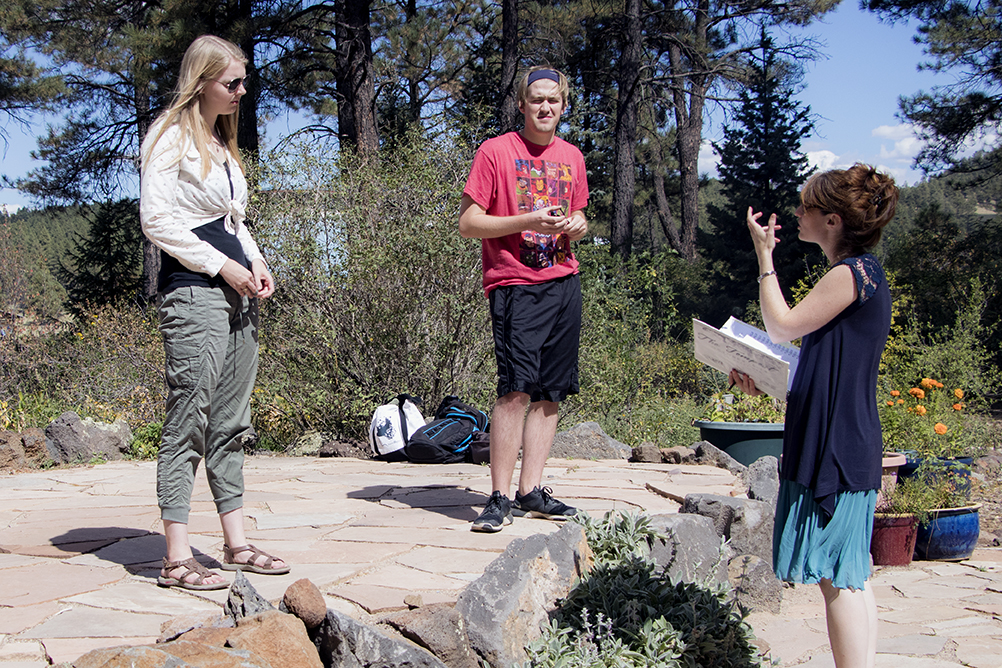
We’re now almost two weeks into the rehearsal process of The Tempest. Slowly but surely we’re making our way through the whole play, focusing on the different groups that arrive and interact on the island. We’ve established a strong bond between Prospero and the supernatural being of Ariel. The nobles, as we’ve started to call them, including the king Alonso with his brother Sebastian, his advisor Gonzalo and follower Adrian, as well as Duke Antonio. This group appears always together in the play and have a curious dynamic, as Antonio and Sebastian constantly try to undermine the pursuit of hope by Gonzalo. Then we rehearsed some heartwarming scenes between Miranda and Ferdinand. It’s astounding to hear Miranda discover the beauty of mankind in her very sincere and truthful way. Finally, the most laughs we’ve had in rehearsals so far has been with the hilarious trio of the drunken butler Stephano, the jester Trinculo and the creature of the island, half-human half-something else, called Caliban. The opposing character personalities in these scenes alone are funny. Caliban’s rage and need for revenge are countered by the drunken Stephano and Trinculo, that every observer understands that any plans forged by these are doomed to fail. But as always it’s wonderfully entertaining to observe their attempts.
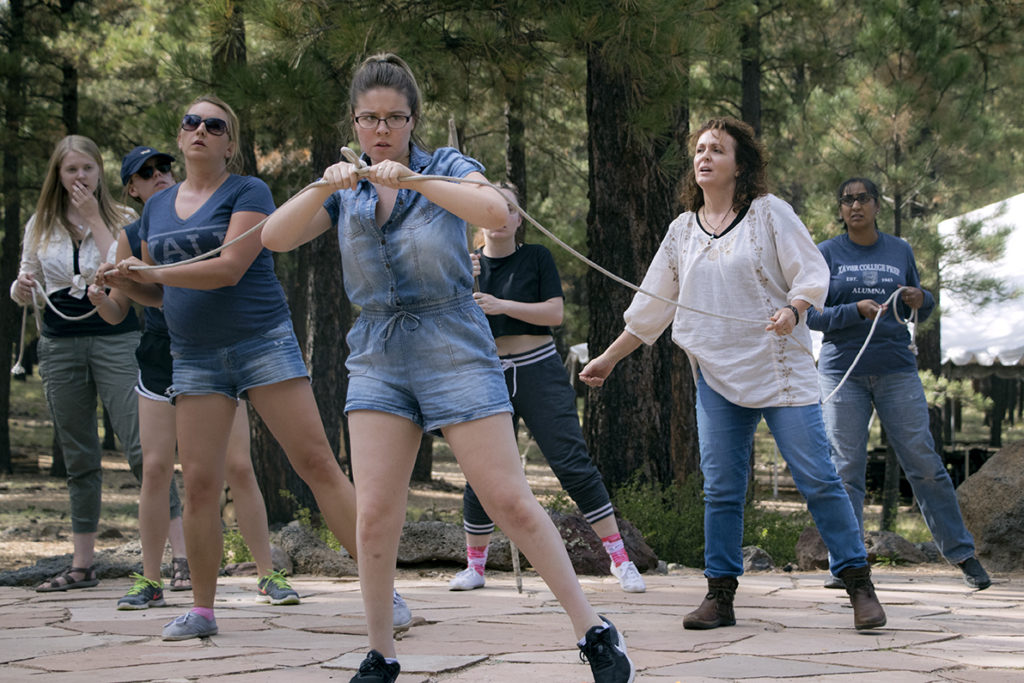
The only new approach we’ve taken with this production is the gender-reversed casting. As it turns out, it’s the first production ever to fully commit to gender-reversed casting, meaning that all roles will be played by the opposite sex. So, if you come to see this production, you’re in for a treat of a world premiere. In a way, you would have expected to trigger a lot of discussions during rehearsals about the casting. But after our first set of ground rules to portray the characters as truthfully and best as we can, our focus in rehearsals has been to tell the story of The Tempest as clearly as possible. We forget how often women are cast to play men’s roles nowadays, so the casting sounds way more outlandish than it is, at least for the women it is just another male role. Even our male actor has acted in women’s roles before.
The most important lesson to learn from the gender-swap is that the acting becomes about the character and what part they play in the story, rather than about gender. Just as in real life, we all can play the same part but we all bring our very own and distinguishable personality to it. And what a joy it is to see that in rehearsals.
In the summer of 1995, I found myself in my first production of The Taming of the Shrew. Fifteen years old, playing Lucentio, and in way over my head, I was exploring this language for the first time. I was struck by how seamlessly the subplot was woven into the fabric of the story, and how even the simplest stock characters had intricately drawn backstories buried ingeniously in the text. The production was straightforward, simplistic in nature and a little barbaric in its treatment of Katherine. Even at a young age, I knew we had swung heartily and missed.
There seemed to me to be much more happening than the tyrannical oppression of an intelligent, independent woman, and something far greater at stake than a man’s comfort and dominance.
Katherine, the “shrew” of the title, is a bold and misunderstood woman surrounded by a Paduan society that values only wealth, position, and the societal rules that govern it. Katherine is the intellectual and moral superior to every inhabitant of this town that we meet, and as she rejects the hypocrites and fools she is surrounded by, she is pushed to fringes of her own home. She is rejected by suitor after suitor, and just as 16th-century spinsterhood is threatening to marginalize her further, we meet Petruchio. A man in mourning, mentioning the recent death of his father three separate times, he is a fortune seeker who, strangely, doesn’t care about the trappings of wealth; someone who will play by this society’s rules, only to upend them completely. When the two meet, sparks fly, wits duel, and hormones go into overdrive.
Theirs is a seduction of the mind, not the body, and it begins at first sight.
Nearly all relationships in this play are transactional in nature, and Katherine and Petruchio are no exception. Katherine’s family strikes a bargain with Petruchio to be rid of the constant in-house challenge that is Katherine, and Petruchio inherits a handsome dowry for his trouble. Instead of trying to understand Katherine’s struggles and actually communicate with her, her family is quite eager to hire someone else to do it for them and rid the house of her. When the wedding day arrives, Petruchio attends, but systematically rejects every social expectation the Paduans have for him and his wife. He spurns their traditions, facades, and hypocrisies and, in taking Katherine to their home to start a new life together, begins his odd courtship.
The “taming” of Katherine in the play’s final two acts is often depicted as abject brutality, a misogynistic terror and a living nightmare for everyone in the house.
While it can be troublesome behavior for a contemporary audience to witness, it’s hardly malevolent. Misguided as his methods are, they are earnest attempts to bring the couple closer together while going through a shared experience. Hunger, sleeplessness, and the absence of finery and affectation are what Petruchio, this young veteran, knows. The closest relationships of his past were forged suffering on the front lines of battle and not in a velvet-draped drawing room. Petruchio’s methods, callous and ham-fisted, are always in pursuit of bringing them closer. While Katherine and Petruchio learn to speak with a common voice, and, through pain, learn to see their world in a new way, they also discover how to subvert it. By the end of the play, Katherine speaks and is heard for the first time by the very people who were so eager to buy, sell, and barter her and her sister away.
Kate and Petruchio are, in the end, the only free and independent characters in their world, and they learn that the only way to truly challenge the system in place is from within.
Petruchio is not an example to follow or a hero, but a problematic and challenging partner for Katherine. He forces us to imagine what may have become of Katherine had she been left with a family so willing to ignore and treat her as a piece of currency. Katherine and Petruchio are both called “mad” many times throughout the play by other characters in their world. Shakespeare boldly challenges his audience and questions society’s treatment of women in The Taming of the Shrew, leaving us to ask ourselves who the mad ones truly are.
–Jesse James Kamps, Director of The Taming of the Shrew





